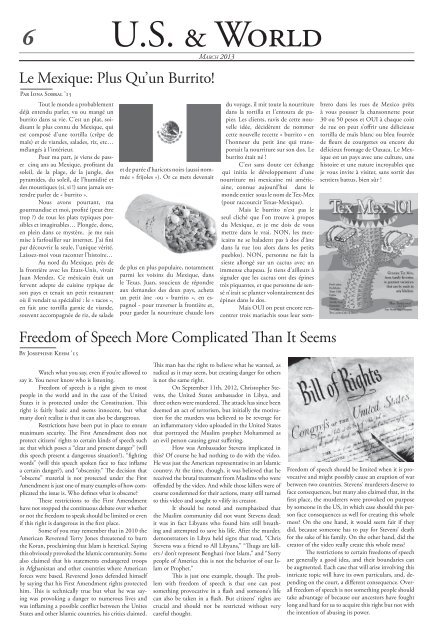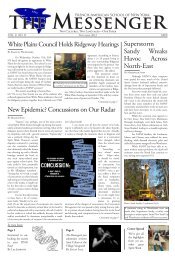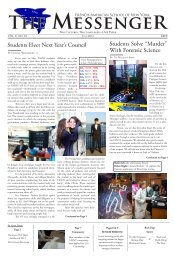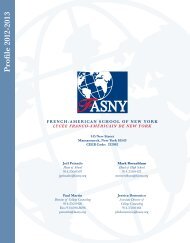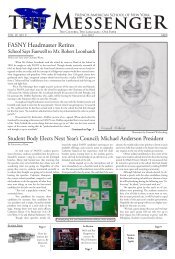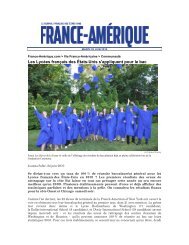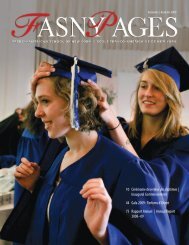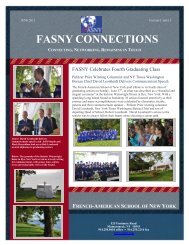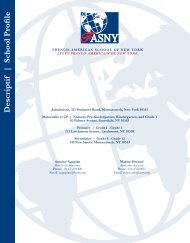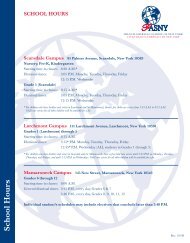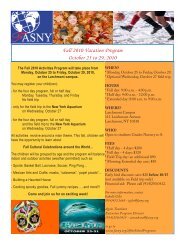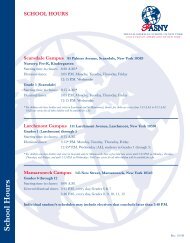ThE MESSENGER - Franco-American School of New York
ThE MESSENGER - Franco-American School of New York
ThE MESSENGER - Franco-American School of New York
- No tags were found...
You also want an ePaper? Increase the reach of your titles
YUMPU automatically turns print PDFs into web optimized ePapers that Google loves.
6<br />
U.S. & World<br />
Le Mexique: Plus Qu’un Burrito!<br />
Par Iona Sobral ’15<br />
Tout le monde a probablement<br />
déjà entendu parler, vu ou mangé un<br />
burrito dans sa vie. C’est un plat, soidisant<br />
le plus connu du Mexique, qui<br />
est composé d’une tortilla (crêpe de<br />
maïs) et de viandes, salades, riz, etc…<br />
mélangés à l’intérieur.<br />
Pour ma part, je viens de passer<br />
cinq ans au Mexique, pr<strong>of</strong>itant du<br />
soleil, de la plage, de la jungle, des<br />
pyramides, du soleil, de l’humidité et<br />
des moustiques (si, si !) sans jamais entendre<br />
parler de « burrito ».<br />
Nous avons pourtant, ma<br />
gourmandise et moi, pr<strong>of</strong>ité (peut être<br />
trop ) de tous les plats typiques possibles<br />
et imaginables… Plongée, donc,<br />
en plein dans ce mystère, je me suis<br />
mise à farfouiller sur internet. J’ai fini<br />
par découvrir la seule, l’unique vérité.<br />
Laissez-moi vous raconter l’histoire…<br />
Au nord du Mexique, près de<br />
la frontière avec les Etats-Unis, vivait<br />
Juan Mendez. Ce méxicain était un<br />
fervent adepte de cuisine typique de<br />
son pays et tenait un petit restaurant<br />
où il vendait sa spécialité : le « tacos »,<br />
en fait une tortilla garnie de viande,<br />
souvent accompagnée de riz, de salade<br />
et de purée d’haricots noirs (aussi nommée<br />
« frijoles »). Or ce mets devenait<br />
de plus en plus populaire, notamment<br />
parmi les voisins du Mexique, dans<br />
le Texas. Juan, soucieux de répondre<br />
aux demandes des deux pays, acheta<br />
un petit âne -ou « burrito », en espagnol<br />
- pour traverser la frontière et,<br />
pour garder la nourriture chaude lors<br />
Ma rc h 2013<br />
du voyage, il mit toute la nourriture<br />
dans la tortilla et l’entoura de papier.<br />
Les clients, ravis de cette nouvelle<br />
idée, décidèrent de nommer<br />
cette nouvelle recette « burrito » en<br />
l’honneur du petit âne qui transportait<br />
la nourriture sur son dos. Le<br />
burrito était né !<br />
C’est sans doute cet échange<br />
qui initia le développement d’une<br />
nourriture mi mexicaine mi américaine,<br />
connue aujourd’hui dans le<br />
monde entier sous le nom de Tex-Mex<br />
(pour raccourcir Texas-Mexique).<br />
Mais le burrito n’est pas le<br />
seul cliché que l’on trouve à propos<br />
du Mexique, et je me dois de vous<br />
mettre dans le vrai. NON, les mexicains<br />
ne se baladent pas à dos d’âne<br />
dans la rue (ou alors dans les petits<br />
pueblos). NON, personne ne fait la<br />
sieste allongé sur un cactus avec un<br />
immense chapeau. Je tiens d’ailleurs à<br />
signaler que les cactus ont des épines<br />
très piquantes, et que personne de sensé<br />
n’irait se planter volontairement des<br />
épines dans le dos.<br />
Mais OUI on peut encore rencontrer<br />
trois mariachis sous leur sombrero<br />
dans les rues de Mexico prêts<br />
à vous pousser la chansonnette pour<br />
30 ou 50 pesos et OUI à chaque coin<br />
de rue on peut s’<strong>of</strong>frir une délicieuse<br />
tortilla de maïs blanc ou bleu fourrée<br />
de fleurs de courgettes ou encore du<br />
délicieux fromage de Oaxaca. Le Mexique<br />
est un pays avec une culture, une<br />
histoire et une nature incroyables que<br />
je vous invite à visiter, sans sortir des<br />
sentiers battus, bien sûr !<br />
Freedom <strong>of</strong> Speech More Complicated Than It Seems<br />
By Josephine Kehm ’15<br />
Watch what you say, even if you’re allowed to<br />
say it. You never know who is listening.<br />
Freedom <strong>of</strong> speech is a right given to most<br />
people in the world and in the case <strong>of</strong> the United<br />
States it is protected under the Constitution. This<br />
right is fairly basic and seems innocent, but what<br />
many don’t realize is that it can also be dangerous.<br />
Restrictions have been put in place to ensure<br />
maximum security. The First Amendment does not<br />
protect citizens’ rights to certain kinds <strong>of</strong> speech such<br />
as: that which poses a “clear and present danger” (will<br />
this speech present a dangerous situation), “fighting<br />
words” (will this speech spoken face to face inflame<br />
a certain danger), and “obscenity.” The decision that<br />
“obscene” material is not protected under the First<br />
Amendment is just one <strong>of</strong> many examples <strong>of</strong> how complicated<br />
the issue is. Who defines what is obscene<br />
These restrictions to the First Amendment<br />
have not stopped the continuous debate over whether<br />
or not the freedom to speak should be limited or even<br />
if this right is dangerous in the first place.<br />
Some <strong>of</strong> you may remember that in 2010 the<br />
<strong>American</strong> Reverend Terry Jones threatened to burn<br />
the Koran, proclaiming that Islam is heretical. Saying<br />
this obviously provoked the Islamic community. Some<br />
also claimed that his statements endangered troops<br />
in Afghanistan and other countries where <strong>American</strong><br />
forces were based. Reverend Jones defended himself<br />
by saying that his First Amendment rights protected<br />
him. This is technically true but what he was saying<br />
was provoking a danger to numerous lives and<br />
was inflaming a possible conflict between the Unites<br />
States and other Islamic countries, his critics claimed.<br />
This man has the right to believe what he wanted, as<br />
radical as it may seem, but creating danger for others<br />
is not the same right.<br />
On September 11th, 2012, Christopher Stevens,<br />
the United States ambassador in Libya, and<br />
three others were murdered. The attack has since been<br />
deemed an act <strong>of</strong> terrorism, but initially the motivation<br />
for the murders was believed to be revenge for<br />
an inflammatory video uploaded in the United States<br />
that portrayed the Muslim prophet Mohammed as<br />
an evil person causing great suffering.<br />
How was Ambassador Stevens implicated in<br />
this Of course he had nothing to do with the video.<br />
He was just the <strong>American</strong> representative in an Islamic<br />
country. At the time, though, it was believed that he<br />
received the brutal treatment from Muslims who were<br />
<strong>of</strong>fended by the video. And while those killers were <strong>of</strong><br />
course condemned for their actions, many still turned<br />
to this video and sought to vilify its creator.<br />
It should be noted and reemphasized that<br />
the Muslim community did not want Stevens dead;<br />
it was in fact Libyans who found him still breathing<br />
and attempted to save his life. After the murder,<br />
demonstrators in Libya held signs that read, “Chris<br />
Stevens was a friend to All Libyans,” “Thugs are killers<br />
/ don’t represent Benghazi /nor Islam,” and “Sorry<br />
people <strong>of</strong> America this is not the behavior <strong>of</strong> our Islam<br />
or Prophet.”<br />
This is just one example, though. The problem<br />
with freedom <strong>of</strong> speech is that one can post<br />
something provocative in a flash and someone’s life<br />
can also be taken in a flash. But citizens’ rights are<br />
crucial and should not be restricted without very<br />
careful thought.<br />
Freedom <strong>of</strong> speech should be limited when it is provocative<br />
and might possibly cause an eruption <strong>of</strong> war<br />
between two countries. Stevens’ murderers deserve to<br />
face consequences, but many also claimed that, in the<br />
first place, the murderers were provoked on purpose<br />
by someone in the US, in which case should this person<br />
face consequences as well for creating this whole<br />
mess On the one hand, it would seem fair if they<br />
did, because someone has to pay for Stevens’ death<br />
for the sake <strong>of</strong> his family. On the other hand, did the<br />
creator <strong>of</strong> the video really create this whole mess<br />
The restrictions to certain freedoms <strong>of</strong> speech<br />
are generally a good idea, and their boundaries can<br />
be augmented. Each case that will arise involving this<br />
intricate topic will have its own particulars, and, depending<br />
on the court, a different consequence. Overall<br />
freedom <strong>of</strong> speech is not something people should<br />
take advantage <strong>of</strong> because our ancestors have fought<br />
long and hard for us to acquire this right but not with<br />
the intention <strong>of</strong> abusing its power.


